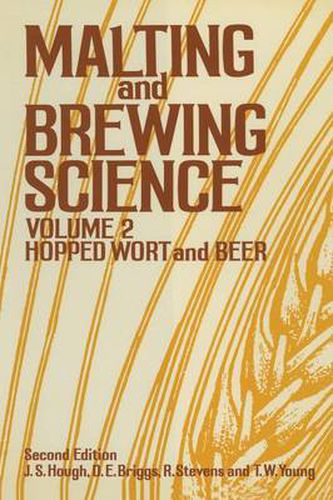Readings Newsletter
Become a Readings Member to make your shopping experience even easier.
Sign in or sign up for free!
You’re not far away from qualifying for FREE standard shipping within Australia
You’ve qualified for FREE standard shipping within Australia
The cart is loading…






This title is printed to order. This book may have been self-published. If so, we cannot guarantee the quality of the content. In the main most books will have gone through the editing process however some may not. We therefore suggest that you be aware of this before ordering this book. If in doubt check either the author or publisher’s details as we are unable to accept any returns unless they are faulty. Please contact us if you have any questions.
Some ten years. have passed since the publication of the first edition of Malting and Brewing Science, a period of many changes. As before, this edition is an aid to teaching, particularly the MSc course in Brewing Science at Birmingham University, but it is also aimed at the requirements of other students of the science of malting and brewing throughout the world. In general, technological aspects are covered more fully in this new edition, although not malting and brewing practices that are exclusive to Britain. Nevertheless, the amount of technological information available is too great to be comprehensively covered iln one book. Scientific principles and infor mation receive more attention, but for details of analytical procedures reference should be made to the most recently published material of the Ameri can Society of Brewing Chemists, the European Brewery Convention and the Institute of Brewing. The new edition appears as two volumes because a single one would be inconveniently bulky. The first volume outlines the entire process and leads from barley, malting and water to the production of sweet wort. In the second volume there are chapters on hops and hop products, production of hopped wort, fermentation,yeast biology and all aspects of beer qualities and treatment. Decisions about the units of measurement proved difficult; metric units commonly used in the Industry are given and in parentheses are equivalents in degrees Fahrenheit, Imperial measures and UK barrels. Considerable information on equivalents is given in a special section in each volume.
$9.00 standard shipping within Australia
FREE standard shipping within Australia for orders over $100.00
Express & International shipping calculated at checkout
This title is printed to order. This book may have been self-published. If so, we cannot guarantee the quality of the content. In the main most books will have gone through the editing process however some may not. We therefore suggest that you be aware of this before ordering this book. If in doubt check either the author or publisher’s details as we are unable to accept any returns unless they are faulty. Please contact us if you have any questions.
Some ten years. have passed since the publication of the first edition of Malting and Brewing Science, a period of many changes. As before, this edition is an aid to teaching, particularly the MSc course in Brewing Science at Birmingham University, but it is also aimed at the requirements of other students of the science of malting and brewing throughout the world. In general, technological aspects are covered more fully in this new edition, although not malting and brewing practices that are exclusive to Britain. Nevertheless, the amount of technological information available is too great to be comprehensively covered iln one book. Scientific principles and infor mation receive more attention, but for details of analytical procedures reference should be made to the most recently published material of the Ameri can Society of Brewing Chemists, the European Brewery Convention and the Institute of Brewing. The new edition appears as two volumes because a single one would be inconveniently bulky. The first volume outlines the entire process and leads from barley, malting and water to the production of sweet wort. In the second volume there are chapters on hops and hop products, production of hopped wort, fermentation,yeast biology and all aspects of beer qualities and treatment. Decisions about the units of measurement proved difficult; metric units commonly used in the Industry are given and in parentheses are equivalents in degrees Fahrenheit, Imperial measures and UK barrels. Considerable information on equivalents is given in a special section in each volume.